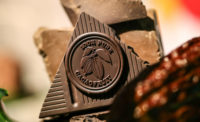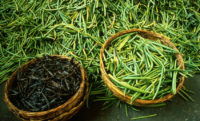![]()
Mother Nature’s Medicine Cabinet
Adding fruit, packed with essential vitamins and disease-fighting nutrients, to baked goods allows bakers to upscale products by making them more healthy.
By Maria Pilar Clark
As cold and flu season approaches, consumers are seeking aid in the pharmacy and the doctor’s office. At a time when people want to stay healthy, we are reminded of the age-old adages our grandmothers used to tell us. An apple a day keeps the doctor away. Vitamin C wards off a cold. Lemon juice and honey soothe a sore throat. These wise words and natural remedies are speaking volumes as today’s latest research advises us to color our world — with fruit.
The Daily Rind
The key to living a fruitful life lies in eating five or more servings of fruit daily as a strong foundation for healthful living. Deeply hued fruit provides the human body with all of the vitamins, minerals, phytochemicals and fiber that it needs to function on a daily basis. Not only does fruit maintain energy levels but it can reduce the risk of heart disease too. Do bite off more than you can chew.
Baked products just taste better with a little bit of Mother Nature’s medicine baked in. Moreover, adding fruit can help bakers create upscale products that command a higher price point.
However, adding fruit like blueberries, peaches, raisins and apples can be tricky because the particulates have varied densities, according to an October 2003 technical bulletin on muffin technology by the American Institute of Baking. Fortunately, this challenge can be overcome.
Researchers note that bakers can use two tools to control the tendency of particulates to sink or float. Increasing the viscosity of batter to slow the movement of particulates through it is done easily by adjusting the amount of water or ingredients that are added to the batter. But reformulating can change the symmetry of the finished product. That’s where the second tool comes in — air. Controlling the amount of air introduced into batter along with particulates can re-balance product symmetry.
With fruit, it’s all about color. The richer the color, the better the benefits.
Blue and purple fruit contain varying levels of health-promoting phytochemicals and substances called anthocyanins and phenolics, currently being studied for their antioxidant and anti-aging benefits. Beneficial dark-colored fruits are blueberries, plums, blackberries, purple figs, purple grapes and raisins.
Adding white, tan and brown fruit to a healthy diet promotes heart wellness, healthy cholesterol levels and a lower risk for contracting some cancers. In this bunch are bananas, brown pears, white peaches, white nectarines and dates.
Eating yellow and orange fruit, such as apricots, cantaloupe, yellow apples, grapefruit, pineapples and a host of others, helps maintain a healthy immune system and healthy vision. Orange and yellow fruits are known for disease-fighting vitamin C levels as well as two types of phytochemicals — carotenoids and bioflavonoids.
Go for the green with avocadoes, green grapes, green apples, kiwi, limes, green pears and honeydew melons. Green fruit contains potent phytochemicals like lutein and indoles, promoting heart and vision health, along with essential vitamin boosts to the immune system.
Lastly, don’t forget to paint the town red with watermelons, blood oranges, red apples and assorted varieties of berries, to improve memory function and urinary tract health.
Plum Crazy
Dried plums are one of many nutritional “superfruits” that enhance not only the nutritional value of baked goods, but also the products’ taste and mouthfeel. They are an excellent source of dietary fiber and contain sorbitol, potassium, magnesium, copper, boron and phenolic compounds, which regulate glucose metabolism, promote cardiovascular health, protect against cancer and aid in digestion.
Since Simple Simon the Pie-man, bakers have been looking for ways to integrate dried plums into baked goods as consumers go plum crazy for more healthful products developed using nutritious, naturally processed ingredients.
Results from the National Health Nutrition Examination Survey III found that individuals who ate dried plums had healthier lifestyles and significantly higher nutrient counts compared to those who did not eat them. Plum eaters also had a significant reduction in blood pressure and considerably higher levels of desirable nutrients including carotenes, folate and vitamins A, E and C in their blood. Dried plums are a rich source of antioxidants, and their unique properties allow bakers to produce a variety of tasty baked goods without the fat, notes Charlie Pfitzer, director of industrial sales for Sunsweet Growers, Inc.
“(Dried plums) are used as a replacement for fat in healthier baking whether it’s mainstream or actually reduced fat products,” he says. “(Fat) is replaced using a plum puree or a dried plum concentrate. If you had one gram of fat, it would be replaced with half a gram of either of the two products and that reduces the fat by a gram. Number one is that almost nine calories are being replaced with about a calorie and a half. So even in regular baking, somewhere in the neighborhood of 17 to 18 calories have been taken out.”
Dried plums are the latest functional bakery ingredient, which is just a bowl of cherries for health-conscious consumers and bakers alike. Tempting product offerings are being rolled out by the bushel — fruit breads, cookies, muffins, cakes, pastries — all without losing any of the taste, texture or “yummy-factor” of their full-fat cousins. Dried plum bits and purees are soft and easily incorporated into doughs and batters, which results in a satisfying eating experience without sacrificing taste.
Pfitzer believes the dramatic rise in the use of dried plums reflects a return to healthier baking.
“In the past when we had low-fat baking, a lot of the low-fat replacements were (substituting) calories for fat,” he says. “In some cases, the amount of calories was going up even though it wasn’t from fat. Dried plums work for the reduction of both fat and calories.”
Berry Good News
Recent studies have shown that grapes, cranberries, blueberries, raspberries and a bounty of other fruits are ripe with health benefits and disease-fighting nutrients.
A study conducted by the City of Hope Cancer Center in Duarte, Calif., found that grapes contain chemicals called procyanidin C dimers that block estrogen — a key player in breast cancer tumor development in postmenopausal women. High levels of estrogen are combated naturally by the substances in grapes that act as aromatase inhibitors and chemopreventative agents against breast cancer.
The grapevine doesn’t stop there. Raisins are the darling of the baking industry, providing sweetness, extended shelf life and flavor enhancement to baked goods. According to the California Raisin Marketing Board, “Research at the American Institute of Baking has shown that the addition of California raisins to bakery products slows the migration of water to starch granules that causes staling in breadstuffs.”
Moreover, they keep the equilibrium levels in products constant, allowing bakers to reduce or eliminate the use of preservatives and additives. Added to everything from scones to soda bread, raisins add interest, flavor and texture, and keep product moist and fresh at the same time.
Cranberries and blueberries offer health “a-peel” by acting as powerful disease fighters. Medical professionals often prescribe pure cranberry juice for the prevention and treatment of minor urinary tract infections. Additionally, the juice helps to keep kidneys filtering at their peak. Go ahead and help yourself to another slice of blueberry pie or a second cranberry muffin after Thanksgiving dinner this year. The proanthocyanidins in cranberries help prevent the growth of E. coli bacteria in the bladder, which in turn assists in the prevention of bladder infections.
Furthermore, cranberries contain phytochemicals called anthrocyanins and phenolics that, according to certain studies, improve memory function, enhance vision, keep arteries free and clear, strengthen blood vessels, reverse the effects of aging and even promote weight control.
Not to be outdone, blueberries are bringing a little “blue magic” to baked goods. According to the U.S. Highbush Blueberry Council, “Blueberries provide unique benefits that translate into economic advantage.”
Blue foods are in, and blueberries are the only naturally occurring blue food found in nature. They can be used in everything from cookie fillings to breakfast bars, bagels to breads and myriad other baked foods. As such, this little berry is enjoying newfound popularity as a trendy bakery application. Baked-in blueberries bits, dried blueberries and osmotically (sugar-infused) preserved blueberries can be found in many desserts and snacks.
Put away those Tums and chomp on some raspberries. A study conducted by University of Helsinki researchers found that raspberries fight harmful stomach bacteria. The phenols in raspberries contain a compound that inhibits the growth of detrimental intestinal bacteria like salmonella, staphylococcus and camphylobacter.
Further research determined that raspberries do not target beneficial probiotic bacteria, which could result in changes to a wide range of food industry applications, including functional foods. Additionally, they could play a role in the development of supplements designed to prevent unpleasant traveler’s ills like Montezuma’s Revenge, which in turn could lead to new forms of protective food packaging, food preservatives and other pharmaceutical applications.
Colorful Crusaders
Fruit has cropped up in the media with conflicting reports as to whether or not it’s really healthy. Several popular diets limit the intake of fruit allowed in one day, while others eliminate it from the menu altogether. With everything from Atkins to the Caveman diet, today’s consumers are confused.
Here’s the truth. No matter how you slice it, what humans consume has a significant impact on their bodies, which is central to how well the body can react around the cold and flu season. Food also plays a big role in how people feel mentally and physically, and foods that are rich in nutrients have been scientifically proven to boost the body’s natural defenses.
A strong immune system is made up of a complex system of organs and cells that work together in order to protect the body against germy invaders like bacteria, parasites, viruses and malignant cells. Nutrients like vitamins A, C and E, found in everything from oranges to kiwi, are essential to maintaining the body’s defense levels.
Colorful fruits are Mother Nature’s (and grandma’s) crusaders, which provide natural sources of antioxidants — plant substances that protect the body by neutralizing free radicals and unstable oxygen molecules, which could potentially damage cells.
Students take note — fruit is good for your noggin. It contains natural sugars, which stimulate the brain to recall information faster and more clearly. Fruit is the ultimate brain fuel and could make the difference between an A+ and something rotten.
Fruit For Thought
Last year, Americans consumed 4 lbs. less fruit than they did in 1985. This year, Americans have rapidly expanding waistlines and are nearly 25 lbs. heavier than they were just 44 years ago. The usual offenders are to blame — processed foods and sedentary lifestyles, where sadly, less is not more. Super-sizing fruit consumption levels however, could do much in terms of pruning the population’s super-sized bellies.
For the most part, fruit is made up of 80% water, much like the human body. The body needs water to function, and fruit provides a good supply along with the vitamins and minerals essential for health. Fruit is 100% cholesterol free — another reason to drop the donuts. It contains high levels of fiber, which is a good way to stem obesity and aid weight control. Moreover, a healthy diet containing plenty of fiber can reduce high blood pressure and protect against heart disease.
Fruit can even chase the blues away. Eating fruit has a mysterious healing effect; think of it as mood food. A number of studies have concluded that people who were frequently depressed found their way out of the gloom sooner by consuming substantial amounts of fresh fruit on a regular basis than their non-fruit eating counterparts.
Fruit holds a bounty of benefits — not only does it have the power to heal, it can protect our bodies from illness and disease, and even make us feel better. Get healthy with five a day for life. Grandma really knew what she was talking about. So go ahead, raid Mother Nature’s medicine cabinet.
Editor’s Note: The American Institute of Baking’s Technical Bulletins are a good source for more information on the integration of fruit into baked goods. For instance, the April 2004 issue explores new roles for raisins in the baking industry while the February 2000 issue focuses on cherries and their use in bakery foods. Call 1-800-633-5137 or visit www.aibonline.org. To learn more about blueberries and raisins, visit the U.S. Highbush Council Web site at www.ushbc.org and email the California Raisin Marketing Board at raisins@tjpmd.com.



